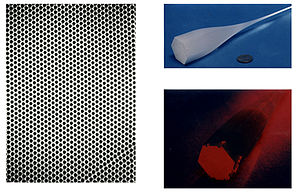- Nanochannel glass materials
-
Nanochannel glass materials are an experimental mask technology that is an alternate method for fabricating nanostructures, although optical lithography is the predominant patterning technique.[1]
Nanochannel glass materials are complex glass structures containing large numbers of parallel hollow channels. In its simplest form, the hollow channels are arranged in geometric arrays with packing densities as great as 1011 channels/cm2. Channel dimensions are controllable from micrometers to tens of nanometers, while retaining excellent channel uniformity. Exact replicas of the channel glass can be made from a variety of materials. This is a low cost method for creating identical structures with nanoscale features in large numbers.[2][3]
Contents
Characteristics
These materials have high density of uniform channels with diameters from 15 micrometres to 15 nanometers. These are rigid structures with serviceable temperatures to at least 300 degrees Celsius, with potential up to 1000 degrees Celsius. Furthermore these are optically transparent photonic structures with high degree of reproducibility.
Applications
These can be used as a material for chromatographic columns, unidirectional conductors, Microchannel plate and nonlinear optical devices. Other uses are as masks for semiconductor development, including ion implantation, optical lithography, and reactive ion etching.[2][3][4]
See also
- E-beam lithography
- Ion beam lithography
- Maskless lithography
- Nanolithography
- Photolithography
- Porous glass
References
- ^ Gimzewski, James K and Welland, M.E; NATO. Scientific Affairs Division. (May 1995). Ultimate limits of fabrication and measurement. Spinger. pp. 13, 14, 15. ISBN 9780792335047. http://books.google.com/books?id=5p3Z1fEI0xwC&pg=PA14&dq=Nanochannel+Glass+Materials&cd=2#v=onepage&q&f=false. * Proceedings of the NATO Advanced Research Workshop, Cambridge, U.K., April 1--3, 1994 Series: NATO Science Series E: (closed), Vol. 292
- ^ a b "Nanochannel Glass Materials" (Online page U.S. Navy website). Naval Research Laboratory. Technology Transfer Office, Code 1004. http://www.nrl.navy.mil/techtransfer/fs.php?fs_id=MAT13. Retrieved 2011-07-04.
- This article includes text from an official United States Navy website. As a work of the U.S. federal government, the text is in the public domain.
- ^ a b Tonucci, Ronald J.; Hubler, Graham K.; Sibilia, Concita; Wiersma, Diederik S. (2007). "Materials Characterization and Nanofabrication Methods—Nanochannel Glass Materials". AIP Conference Proceedings. 959. pp. 59–71. doi:10.1063/1.2821605.
- ^ Pearson, D. H.; Tonucci, R. J. (1995). "Nanochannel Glass Replica Membranes". Science 270 (5233): 68–70. Bibcode 1995Sci...270...68P. doi:10.1126/science.270.5233.68.
Further reading
- Bryant, Garnett W. (1999). "Near-field scanning optical microscopy imaging: theory, simulation, and experiment". Proceedings of SPIE. 3609. pp. 67–75. doi:10.1117/12.351044. http://lib.semi.ac.cn:8080/tsh/dzzy/wsqk/SPIE/vol3609/3609-67.pdf. Free PDF download.
- U.S. Patent 5,976,444 "Nanochannel glass replica membranes"
Categories:- Materials science
- Glass
- Glass engineering and science
- Glass applications
Wikimedia Foundation. 2010.

